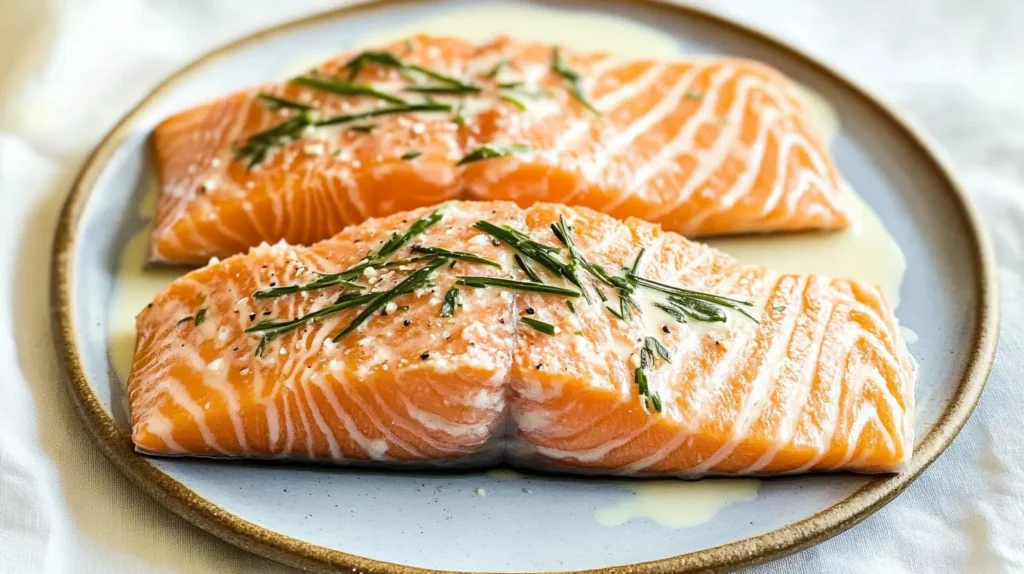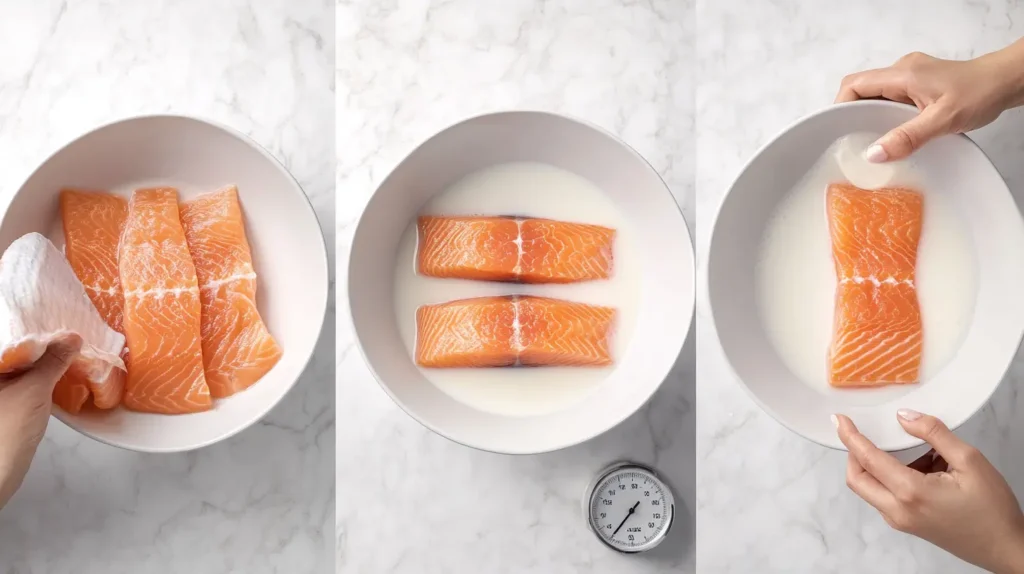What Does Soaking Salmon in Milk Do? If you’ve ever wondered why some chefs and home cooks swear by this simple trick, you’re not alone. Soaking salmon in milk is an age-old method used to remove fishy odors, enhance flavor, and improve texture. But does it actually work?
In this article, we’ll explore the science behind soaking salmon in milk, how long you should do it, and whether it’s really the best way to prepare your fish. You’ll also discover expert insights, common myths, and alternative methods to keep your salmon fresh and delicious.
Let’s dive in!
Table of Contents
Introduction to Soaking Salmon in Milk
Why Do People Soak Salmon in Milk?
If you’ve ever bought fresh salmon and noticed a strong, fishy odor, you’re not alone. This smell develops as fish naturally break down and release trimethylamine oxide (TMAO)—a compound responsible for the “oceanic” scent. While fresh fish should never smell rotten, even high-quality salmon can carry a mild fishiness that some people find unappetizing.
That’s where milk comes in. Many people believe that soaking salmon in milk for a short period can neutralize these odors, making the fish taste fresher. But is this just an old wives’ tale, or is there actual science behind it?
Brief History and Cultural Use of This Method
Soaking fish in milk isn’t a new concept. Coastal communities have been using this trick for generations, particularly in the southern United States and parts of Europe. Many traditional recipes call for soaking fish in buttermilk, cream, or even yogurt before cooking.
Why? Because dairy products contain casein, a protein that binds to trimethylamine (TMA), the compound that causes fishy smells. By soaking salmon in milk, casein helps pull out TMA, leaving behind a fresher-tasting fillet.
This method isn’t exclusive to salmon—it’s commonly used for other strong-smelling fish like cod, tuna, and mackerel. However, salmon’s firm texture and rich oil content make it an especially good candidate for milk soaking.
Overview of the Benefits and Misconceptions
Many people assume that soaking salmon in milk only removes the fishy odor, but that’s just one of its benefits. Some additional perks include:
✔️ Improving texture – Milk can tenderize salmon, making it softer and juicier.
✔️ Enhancing flavor – Soaking fish in milk can subtly mellow out strong flavors without masking its natural taste.
✔️ Reducing excess blood and impurities – A short soak in milk can help remove leftover blood spots and clean the fish naturally.
But there are also some misconceptions:
❌ Milk doesn’t “cook” the salmon – Unlike acids (such as lemon juice or vinegar), milk won’t chemically “cook” the fish like a ceviche marinade.
❌ It won’t completely transform bad fish – If salmon smells rotten or overly pungent, soaking it in milk won’t save it—it’s likely spoiled.
Now that we understand why people soak salmon in milk, let’s explore the science behind it in the next section.
The Science Behind Soaking Salmon in Milk
How Milk Interacts with Salmon Proteins
Milk isn’t just a neutral soaking liquid—it actively interacts with the proteins in salmon. The key player here is casein, a protein found in milk that binds to trimethylamine (TMA), the compound responsible for that fishy odor.
When salmon sits in milk for a short period, the casein pulls TMA away from the flesh, reducing the unwanted smell. Unlike acidic marinades (like lemon juice or vinegar), which can start to “cook” the fish, milk is gentle and preserves the natural texture.
Casein in Milk: The Key to Reducing Fishy Smell
The effectiveness of milk in neutralizing fish odor lies in casein’s ability to trap and remove TMA molecules. This is why buttermilk, which has a higher casein content than regular milk, is often recommended for marinating seafood.
As TMA binds to casein, it gets suspended in the liquid, and once you discard the milk, you’re also tossing away a good portion of the fishy smell. This simple trick makes salmon taste fresher and cleaner.
The pH Factor: Does Milk Affect Texture and Taste?
Another interesting aspect of milk soaking is its mild pH level, which hovers around neutral (6.5-6.7). Unlike acidic marinades, milk does not denature proteins as aggressively, meaning it won’t toughen the fish.
Instead, milk subtly hydrates the flesh, making it slightly softer and more tender. Some chefs argue that this can improve the mouthfeel, especially when grilling or baking salmon.
So, is soaking salmon in milk just a gimmick? Not at all—it’s a scientifically backed method that actually works.
Does Soaking Salmon in Milk Remove the Fishy Smell?

Why Does Salmon Develop a Fishy Odor?
All fish contain trimethylamine oxide (TMAO), a compound that helps regulate water pressure in their cells. However, once a fish is caught and starts to age, bacteria and enzymes break TMAO down into trimethylamine (TMA)—the culprit behind that strong fishy smell.
Wild salmon, being naturally fattier, tends to have higher TMA levels, which means it can develop a stronger odor than leaner white fish like cod or tilapia.
How Milk Neutralizes the Odor
So, what does soaking salmon in milk do to fight the fishy smell? It’s all about the interaction between casein and TMA.
When salmon soaks in milk, the casein proteins bind to the TMA molecules, effectively pulling them away from the fish’s surface. The result? A fresher, more pleasant-smelling fillet.
For best results:
✔️ Use whole milk (or buttermilk) for a richer effect.
✔️ Soak for 20-30 minutes—any longer won’t add much extra benefit.
✔️ Pat dry before cooking to ensure a proper sear or crisp skin.
Comparing Milk Soaking to Other Methods
If you’re not a fan of using milk, here are some alternative ways to reduce fishy odors:
🟢 Lemon juice – A quick acidic soak can help neutralize odor but may slightly “cook” the salmon.
🟢 Saltwater brine – A short brine in saltwater can help extract impurities while preserving flavor.
🟢 Vinegar rinse – Like lemon juice, it works but can alter the fish’s texture.
Milk stands out because it’s gentle, effective, and preserves the natural taste of salmon without altering its texture.
Other Benefits of Soaking Salmon in Milk
Improved Flavor and Texture
Many people assume that soaking salmon in milk is just about eliminating odor, but it does more than that. The milk subtly enhances both flavor and texture, giving the fish a fresh and delicate taste.
Unlike acidic marinades that can overpower the salmon’s natural sweetness, milk works gently. It slightly mellows the briny taste while preserving the rich, buttery quality of the fish. This is especially beneficial if you’re preparing wild-caught salmon, which tends to have a stronger flavor than farm-raised varieties.
Texture-wise, milk soaking helps the flesh remain moist and tender. This is particularly useful for baking or pan-searing, where dry, overcooked fish can be a problem.
Tenderizing the Salmon
One lesser-known effect of milk is its ability to tenderize salmon. Because milk contains a balanced pH and casein proteins, it helps break down some of the tougher muscle fibers in the fish. This makes the salmon softer and juicier without making it mushy.
For best results, let your salmon sit in milk for 20 to 30 minutes before cooking. This will ensure the fillet absorbs just enough moisture without becoming too delicate.
Removing Impurities and Excess Blood
Another hidden benefit of soaking salmon in milk is its ability to remove impurities. Sometimes, you may notice small blood spots or a slightly cloudy residue in the milk after soaking the fish—this is normal!
Milk helps pull out tiny bits of residual blood and surface proteins, making the fillet appear cleaner and more appealing. This can be particularly useful when dealing with previously frozen salmon, which may contain more excess moisture than fresh fish.
So, what does soaking salmon in milk do besides removing the fishy smell? It enhances flavor, boosts tenderness, and leaves your fish cleaner and fresher—all without overpowering its natural taste.
Step-by-Step Guide: What Does Soaking Salmon in Milk Do?

Choosing the Right Milk: Whole, Skim, or Buttermilk?
Not all types of milk work the same way when soaking salmon. Here’s a breakdown of the best options:
✔️ Whole Milk – The most commonly used option, whole milk contains a good amount of casein and fat, which helps remove odors and keep the fish moist.
✔️ Buttermilk – Since buttermilk has more casein than regular milk, it’s even more effective at neutralizing strong fishy smells. It also gives a slight tang, which can add an extra depth of flavor.
✔️ Skim Milk – While still effective, skim milk lacks the fat content of whole milk, making it slightly less beneficial for texture improvement.
If you want the best results, whole milk or buttermilk is your best bet!
How Long Should You Soak Salmon?
Timing is crucial when soaking salmon in milk. Too little time, and the milk won’t have enough impact; too long, and the fish could become overly soft.
📌 Recommended soaking time: 20 to 30 minutes.
This timeframe is long enough for the milk to bind with the trimethylamine (the fishy-smelling compound) but not so long that it significantly alters the texture of the fish.
Should You Rinse the Salmon After Soaking?
A common question people ask is whether they should rinse their salmon after soaking it in milk. The answer? No need!
Since milk is mild and doesn’t leave an overpowering residue, you can simply pat the salmon dry with a paper towel before cooking. This helps maintain the moisture without making the fish soggy.
However, if you used buttermilk and want to remove its slight tangy flavor, a quick rinse under cool water is fine.
Common Myths About Soaking Salmon in Milk
Does Milk Make Salmon Taste Weird?
One of the biggest myths surrounding this method is that soaking salmon in milk will alter its taste in an unpleasant way. Some people worry that the fish will absorb a strong dairy flavor, making it taste off. However, that’s simply not true!
Milk has a very mild taste, and because salmon is naturally rich and flavorful, it doesn’t take on a milky flavor. Instead, milk gently neutralizes any overpowering fishiness, leaving the salmon tasting cleaner and fresher.
In fact, many professional chefs recommend milk-soaking precisely because it subtly enhances the fish’s natural flavors without overpowering them.
Can You Soak Any Type of Fish in Milk?
While this technique is popular for salmon, it’s not exclusive to this type of fish. Milk soaking works well for other fatty fish, such as:
- Tuna – Reduces any strong, metallic taste.
- Mackerel – Helps balance its bold, oily flavor.
- Cod – Works to remove any lingering “fishy” aftertaste.
However, this method isn’t always necessary for mild white fish like tilapia or haddock, which naturally have a light, neutral flavor.
Is Milk the Best Method Compared to Others?
Another common misconception is that milk is the only way to remove the fishy smell from salmon. While it’s one of the most effective methods, it’s not the only option.
Lemon juice, saltwater brines, and vinegar rinses can also help neutralize unwanted odors. But what makes milk unique is that it removes fishiness without drastically altering the texture or taste.
So, what does soaking salmon in milk do that other methods don’t? It gently binds to odor-causing compounds while preserving the fish’s natural richness—making it a top choice for home cooks and chefs alike.
Alternative Methods to Reduce Fishy Smell in Salmon
Using Lemon or Vinegar Instead of Milk
If you don’t have milk on hand or simply prefer another approach, using lemon juice or vinegar is a great alternative. These acidic ingredients help break down trimethylamine (TMA), the compound responsible for fishy odors.
✔️ Lemon juice – Adds a bright, citrusy note while eliminating unwanted smells.
✔️ White vinegar – Effectively neutralizes odors, but may slightly alter the texture of the fish.
✔️ Apple cider vinegar – Works like white vinegar but adds a mild fruity undertone.
However, acidic treatments can start to “cook” the fish if left too long, so keep the soaking time under 10 minutes to prevent the salmon from becoming tough.
Brining Salmon in Salt Water
A quick saltwater brine can also help remove impurities and unwanted odors. Simply dissolve 1 tablespoon of salt per cup of water, submerge the salmon, and let it sit for 15-20 minutes.
Salt draws out excess moisture, which can carry some of the stronger fishy compounds with it. Plus, it lightly seasons the fish from within, improving the flavor.
Soaking in Baking Soda Solution
For a more science-based approach, a baking soda solution can work wonders. Baking soda is alkaline and helps neutralize odors by balancing the pH of the fish.
To use this method, mix 1 teaspoon of baking soda per cup of water, soak the salmon for 10-15 minutes, and then rinse thoroughly.
While these alternatives work well, soaking salmon in milk remains the most balanced option, as it removes fishiness while preserving the delicate texture of the fish.
Expert Opinions and Scientific Studies
Chef Insights on Milk-Soaked Salmon
Many professional chefs and seafood experts swear by the milk-soaking technique to enhance the taste and texture of salmon. Renowned chefs often recommend this method, especially when working with wild-caught salmon, which tends to have a stronger, more pronounced flavor.
According to seafood chefs, soaking salmon in milk before cooking helps ensure a fresher, cleaner taste, making it ideal for grilling, baking, or pan-searing. Some chefs even use buttermilk instead of regular milk to add a slight tang while tenderizing the fish.
Additionally, chefs emphasize that milk does not overpower the natural flavor of salmon, unlike stronger acidic marinades, which can sometimes alter the fish’s delicate balance.
Scientific Studies on the Effectiveness of Milk for Deodorizing Fish
Science backs up this kitchen trick! Research has shown that casein, a protein found in milk, binds to trimethylamine (TMA), the compound responsible for the fishy smell. As a result, soaking salmon in milk helps remove the strong odor, leaving behind a more neutral scent and taste.
Additionally, studies suggest that the neutral pH of milk helps maintain the texture of the fish without breaking down its proteins too aggressively. This explains why milk is a gentler alternative to acidic treatments like lemon juice or vinegar, which can slightly toughen the flesh.
So, what does soaking salmon in milk do on a scientific level? It neutralizes odors, preserves texture, and enhances flavor—all in a simple, effective process.
FAQs About Soaking Salmon in Milk
1. How long should I soak salmon in milk?
The recommended soaking time is 20 to 30 minutes. This allows the casein proteins in milk to effectively bind with odor-causing compounds, reducing fishiness without making the fish overly soft. If you soak it much longer, there won’t be additional benefits.
2. Does milk change the taste of salmon?
No, soaking salmon in milk does not make it taste milky. Instead, it removes unwanted fishy odors and enhances the fish’s natural flavor. Some chefs even prefer using buttermilk for a slight tang while also helping to tenderize the fillet.
3. Can I soak frozen salmon in milk?
Yes, but for the best results, thaw the salmon first. Milk works by binding to trimethylamine (TMA), the compound responsible for fishy smells, and it needs direct contact with the fish to be most effective. Soaking frozen salmon won’t achieve the same results.
4. What is the best alternative to milk for soaking salmon?
If you don’t have milk, here are some other options:
✔️ Lemon juice – Neutralizes odor but can slightly change texture.
✔️ Saltwater brine – Removes impurities while seasoning the fish.
✔️ Baking soda solution – Balances pH and reduces fishy smell.
However, what does soaking salmon in milk do that these methods don’t? It removes fishiness without affecting texture, making it the best overall method.
For another delicious way to enjoy salmon, check out this Salmon Bites Recipe for an easy, flavorful

